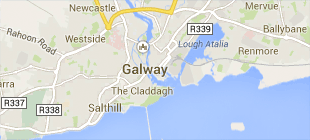-
Cúrsaí
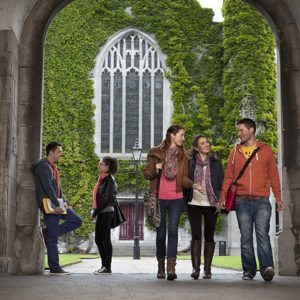
Cúrsaí
Tá roghnú cúrsa léinn ar cheann de na cinntí is tábhachtaí dá ndéanfaidh tú choíche! Féach na cúrsaí atá againn anseo agus an méid a deir mic léinn agus léachtóirí faoi na cúrsaí sin a bhfuil spéis agatsa iontu.
-
Saol na hOllscoile
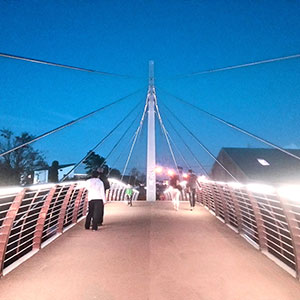
Saol na hOllscoile
Chuile bhliain roghnaíonn os cionn 4,000 duine Ollscoil na Gaillimhe mar chéad rogha. Faigh amach faoin saol in Ollscoil na Gaillimhe anseo.
-
Eolas Fúinn
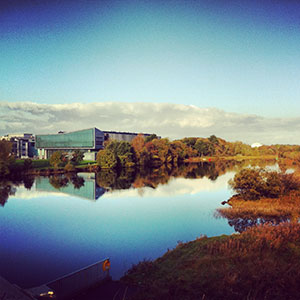
Eolas faoi Ollscoil na Gaillimhe
Bí ar an eolas faoin Ollscoil seo agus na fáthanna a bhfuil sí chomh speisialta sin – an stair thar a bheith spéisiúil a bhaineann leis an Ollscoil agus an nuacht is déanaí agus na hócáidí atá ar na bacáin.
-
Coláistí & Scoileanna
- Scoil na Tíreolaíochta, na Seandálaíochta agus Léann Éireannaigh
- Coláiste an Ghnó, an Bheartais Phoiblí & an Dlí
- Coláiste an Leighis, an Altranais & na nEolaíochtaí Sláinte
- Coláiste na hEolaíochta agus na hInnealtóireachta
- Scoil na dTeangacha, na Litríochtaí agus na gCultúr
- Roinn na Gaeilge
- An tAcadamh
- Stair
- Idirnáisiúnta

Coláistí & Scoileanna
Tá aitheantas idirnáisiúnta bainte amach ag Ollscoil na Gaillimhe mar ollscoil atá á treorú ag an taighde agus rún daingean aici teagasc den chéad scoth a chur ar fáil i réimsí éagsúla saineolais.
-
Taighde
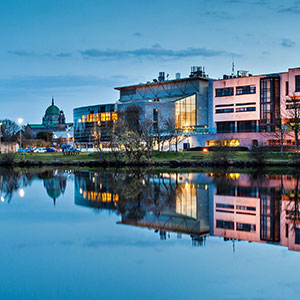
Nithe Fónta á gCruthú as Smaointe Úra
Tugann ár dtaighdeoirí aghaidh ar chuid de na dúshláin is práinní san 21ú Céad.
-
Gnó & Tionscal
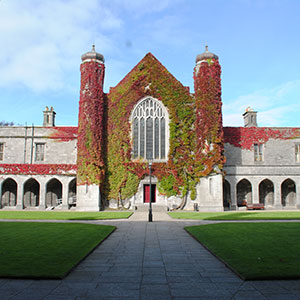
Tacaíocht do Thaighde Úrnua in Ollscoil na Gaillimhe
Déanaimid deiseanna tráchtála a chuardach agus a chothú don phobal taighde in Ollscoil na Gaillimhe, mar aon le comhpháirtíocht tionsclaíochta a chothú.
-
Alumni, Cairde & Lucht Tacaíochta

Alumni, Cairde & Lucht Tacaíochta
Tá os cionn 90,000 céimí de chuid Ollscoil na Gaillimhe ann ar fud an domhain. Déan nasc linn agus beidh teacht agat ar an gcomhphobal sin ar líne.
-
Rannpháirtíocht Pobail
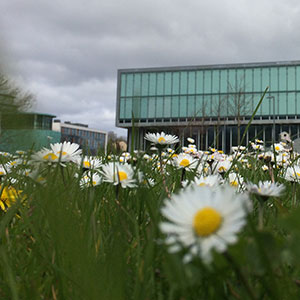
Rannpháirtíocht sa Phobal
In Ollscoil na Gaillimhe, creidimid go n-éireoidh níos fearr leat más féidir leat an méid a fhoghlaimíonn tú a chur i bhfeidhm i do shaol féin. Is mar gheall air sin go bhfuil béim mhór ar shocrúcháin oibre nó ar thionscadail phobail i gcuid mhór dár gcúrsaí.
Latest University News
3 December 2025
University of Galway awarded Silver Athena Swan for equality
University of Galway has been awarded an institutional Silver Athena Swan award - a milestone in the University’s commitment to advancing equality and fostering an inclusive culture.
The Silver award recognises a strong institutional commitment to equality and clear evidence of progress and impact, building on the foundations of two previous Bronze awards.
The formal accreditation was given to the University at the National Athena Swan awards event in SETU, Carlow.
University initiatives and interventions commended by Athena Swan Ireland in the award of the Silver accreditation include increasing the representation of women in senior academic grades and in leadership positions.
This includes:
A 15% rise in the proportion of females across all senior grades from 2015 to 2024.
The proportion of female senior lecturers in University of Galway has increased from 31% in 2017 to 47% in 2025.
The proportion of female professors has increased from 13% in 2017 to 30% in 2025.
In two other areas there has been further significant change with the proportion of female Heads of Schools increasing from 35% in 2017, to 56% in 2025, and the proportion of female Deans up from 14% in 2017, to 50% in 2025.
Alongside the institutional recognition, 14 of the University’s schools now hold Athena Swan awards – with 2 schools recognised with a Silver award, and 12 schools with Bronze.
In 2024-2025, the J.E. Cairnes School of Business and Economics was awarded Silver; the School of Languages, Literatures and Cultures and the School of Political Science and Sociology received their first Bronze awards; and the School of Nursing and Midwifery and School of Psychology renewed their Bronze awards.
Professor David Burn, President of University of Galway, said: "I warmly congratulate our Vice-President for Equality, Diversity and Inclusion Dr Helen Maher, her team and the whole University community for their dedication in achieving an Athena Swan Silver institutional award. These awards are a testament to the sustained work of the University in improving gender equality and enhancing the lived experience of students and staff.
“Athena Swan at University of Galway now addresses not only gender, but the broader culture and experience of staff from all staff categories, embedding equality, diversity and inclusion into the fabric of University life. I look forward to working together with staff and students to continue our collaborative efforts and commitment to further advance equality and foster an inclusive culture at the University."
Dr Helen Maher, Vice-President for Equality, Diversity and Inclusion at University of Galway, said: “Our new Silver Athena Swan accreditation is both an acknowledgement of how far we have come, and a reminder of our responsibility to continue to advance equality for all. This award reflects the vision and dedication of staff and students throughout our University community, and our shared commitment to making University of Galway a place where everyone feels valued and accepted. While we remain cognisant of the extensive work to do, we are proud of this progress and determined to build on it.”
Athena Swan also praised the University’s 2025-2030 Equality Diversity Inclusion (EDI) action plan which is likely to drive substantial change in areas where issues have been identified.
Robust internal Equality Diversity Inclusion (EDI) and governance structures within the University were also noted, as was the annual funding of €3,000 for Athena Swan activities such as scholarships and events, at School and Unit level offered by the Office of the Vice President for Equality, Diversity and Inclusion.
Over the past decade, led by the Office of the Vice President for Equality, Diversity and Inclusion, University of Galway has taken a proactive and collaborative approach to tackling historic challenges in relation to gender equality, leading to a genuine and sustainable cultural shift over time.
Athena Swan is an internationally recognised charter for gender equality in higher education and research. In Ireland, it is overseen by Advance HE and supported by the Higher Education Authority. The Silver award places University of Galway among a select group of institutions demonstrating sustained, evidence-based change.
Sarah Fink, Head of Athena Swan Ireland, said: “This Silver Athena Swan award highlights the fantastic commitment of University of Galway in bringing about change through impactful and sustainable gender equality initiatives in higher education across Ireland. Congratulations to all those who work so hard to achieve and sustain this recognition.”
Jennie Rothwell, Centre of Excellence for Equality, Diversity and Inclusion, Higher Education Authority, said: "Action plans developed through the Athena Swan Ireland Charter enable higher education institutions and departments to take an evidence-based approach to addressing gender equality challenges. Congratulations to University of Galway in taking this step forward to advance gender equality for all staff and students."
Ends
2 December 2025
University of Galway partners with Government of Ukraine to strengthen democracy and media education
University of Galway is to take a major international role in supporting the media ecosystem and democratic development in Ukraine with a new cooperation agreement with President Volodymyr Zelensky’s government.
The Memorandum of Cooperation was signed at a meeting in Dublin today, which was hosted by the First Lady of Ukraine Olena Volodymyrivna Zelenska.
The agreement between University of Galway and the Government of Ukraine sets out joint work on democracy, media and public communication as the country continues to defend itself from the Russian invasion and sustained Russian disinformation efforts aimed at weakening European democracy and public trust.
The agreement confirms the University as a partner in the Global Coalition of Ukrainian Studies, an international initiative coordinated by the Office of the President of Ukraine to strengthen academic cooperation and counter the effects of the ongoing war and the wider information threats facing Europe.
President of University of Galway Professor David Burn and Associate Professor Tom Felle attended on behalf of the University.
The agreement establishes a structured programme of cooperation on media literacy, democratic resilience and the rule of law. It reflects the University’s growing role in European debates on democracy and public communication and supports Ukraine as it continues to defend its sovereignty and progress towards European Union membership.
President of University of Galway Professor David Burn said: “Ukraine’s defence of democracy and European identity goes to the heart of our mission as a university for the public good. Galway has become a leading academic centre for work on media, democracy, digital governance and human rights, and our researchers influence policy discussions across Europe. This Memorandum strengthens that work in partnership with Ukraine at a moment of sustained pressure on democratic institutions and the information environment. It sets out the kind of contribution a university of our scale and ambition should make in Europe today.”
Associate Professor of Journalism and Media Tom Felle said: “Democracy relies on informed citizens and a resilient media system. Ukraine’s journalists, educators and students continue to work under extreme conditions. This agreement allows us to support them and to deepen academic cooperation while ensuring our own students engage directly with the realities of a country defending its freedoms. Galway is committed to playing a constructive role in this partnership and to working with institutions that share a commitment to democratic principles.”
University of Galway currently hosts more than 50 Ukrainian students across a wide range of disciplines. They include Vladyslav Piatin Ponomarenko whose documentary Imagine War, 75 Days of Survival in Mariupol won the Film Documentary of the Year award at the 2025 National Student Media Awards.
University of Galway is recognised internationally for its work on democracy, media and digital governance. Research at the University addresses disinformation, platform regulation, information integrity and the role of independent journalism in democratic life. It also contributes to European policy discussions on the Digital Services Act and the European Media Freedom Act and is known internationally for rigorous teaching and research in journalism and global media.
The partnership includes future cooperation with leading institutions in Kyiv, including the Mohyla School of Journalism at the National University of Kyiv Mohyla Academy and the Faculty of Journalism at Taras Shevchenko National University of Kyiv. Future planned activity includes joint teaching, guest lectures, shared research and opportunities for Ukrainian scholars and students to work with colleagues in Galway. The agreement will also embed Ukrainian case studies and expertise across media and democracy teaching at the University.
Ends
1 December 2025
University announces new UNESCO Chair in Children, Youth, and Civic Engagement
Professor John Canavan appointed to globally recognised research role
Professor John Canavan has been announced as the new UNESCO Chair in Children, Youth, and Civic Engagement at University of Galway.
The appointment has been marked with an inaugural lecture by Professor Canavan, exploring how society can advance knowledge and practice to improve the lives of children and young people.
The event showcased the work of the team of researchers working with the UNESCO Chair, as well as the values and guiding principles which underpin their work, and to demonstrate their contribution to the mission of UNESCO and the wider United Nations system.
Professor Canavan is a Personal Professor in Political Science and Sociology and the Director of the UNESCO Child and Family Research Centre, which he co-founded at University of Galway in 2007. The UNESCO Chair programme in Children, Youth and Civic Engagement at the University was established in 2008 and is delivered through the UNESCO Child and Family Research Centre.
Professor Canavan said: “My vision for the UNESCO Chair is to make a significant contribution to global policy and practice in the field of children and young people’s wellbeing, through our team’s scientific research and evaluation programme focused on Empathy, Mentoring, Youth as Researchers, Family Support and Alternative Education.”
The 2025-2029 programme for the UNESCO Chair in Children, Youth and Civic Engagement focuses on five thematic areas - youth empathy and civic engagement; youth mentoring; family support; youth engagement and participation; and alternative education.
It also includes a number of objectives:
to enhance and further develop existing work focusing on: Empathy/Social and Emotional Learning; Youth Mentoring; Alternative Education; and the Youth as Researchers (YAR) model.
to develop a UNESCO position on family support as a policy paradigm that supports parents and wider family in meeting the needs of excluded children and young people in educational and inter-sectoral settings; and
to embed policy and systems change as a cross-cutting theme across all work programmes seeking more effective bridging of policy and research worlds for greater societal impact.
The former UNESCO Chair, Professor Pat Dolan, who held the role from 2008 to 2024, has been appointed Professor Emeritus at University of Galway.
Ends









